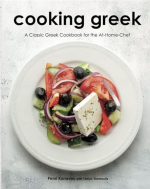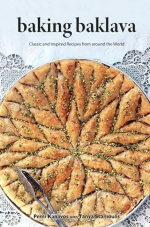See our popular Cooking Greek and Baking Baklava Cookbooks this holiday season!
Cooking Greek Cookbook

Buy Cooking Greek Cookbook HERE!
This visually beautiful cookbook contains over 200 pages of flavorful and delicious classic Greek recipes presented in a simple and easy-to-follow manner for all level at-home chefs.
Greek cuisine can seem intimidating, but when presented by chef Pemi it is anxiety free! With a culinary arts degree, experience teaching Greek cooking classes, and thousands of hours in her yiayia’s (grandmother’s) kitchen, chef Pemi brings a unique perspective with her flavor profile, instructions and beautiful full page photos of each dish.
Cooking Greek: A Classic Greek Cookbook for the At-Home Chef, is the perfect cookbook for foodies and makes a great gift for any occasion.
Discover how to cook some of the most popular, authentic Greek recipes including baklava, tiropita (cheese pie), dolmades (stuffed grape leaves), pastitsio (macaroni pie), spanakopita (spinach pie), moussaka (eggplant and ground beef pie), Greek meatballs, loukoumades (Greek donuts), tzatziki( cucumber yogurt dip), souvlaki (meat skewers), galaktoboureko (milk pie), Greek style octopus and many more mouth-watering Greek recipes.
Chef Pemi Kanavos and Tanya Stamoulis of Worldwide Greeks, have created a visually stunning, classic Greek cookbook for all levels of at-home chefs. Pemi Kanavos is a classically-trained pastry chef with a culinary arts degree and a love of feeding people, and sharing her Greek culture and cuisine.
Baking Baklava Cookbook

Buy Baking Baklava Cookbook HERE!
This stunning 100-page, 27 recipe, high quality baking cookbook is a perfect handbook for bakers and baklava lovers alike.
The Baking Baklava cookbook pays tribute to baklava, a renowned delicacy treasured in many countries around the world, with simple and easy-to-follow baklava recipes for all skill levels. Also included are over dozen delicious dessert recipes inspired by the flavors and textures of baklava.
People are often intimidated by baking, particularly with a delicate dessert like baklava, but when presented by Chef Pemi it is anxiety free! With a culinary arts degree in pastry, experience teaching cooking classes, and thousands of hours in her kitchen, Chef Pemi brings a unique perspective with her flavor profile, instructions and beautiful full page photos of each dessert.
Baking Baklava: Classic and Inspired Recipes from Around the World, is the perfect cookbook for dessert lovers and makes a great gift for any occasion with 27 traditional and inspired baklava recipes.
Explore baklava recipes from various countries including: Greek Baklava, Persian Baghlava, Turkish Soguk or Cold Baklava, Albanian Bakllave, Syrian Pistachio Lady’s Bracelet Baklava, Azeri Pakhlava, Lebanese Baklava, Armenian Chor Paxlava and Jordanian Warbat Baklava.
Chef Pemi has also created delicious Baklava-inspired recipes paying homage to a classic with modern twists such as: Baklava Cheesecake, Chocolate Hazelnut Baklava, Caramel Apple Baklava Rolls, Caramel Chocolate Peanut Crinkle Baklava, Bacon-Pecan-Cognac Baklava, Baklava Ice Cream Tarts, Chocolate Peanut Butter Baklava and more…
For those with dietary restrictions, Chef Pemi has adapted classic Baklava recipes to include Gluten-Free Baklava, Nut-Free Baklava and Vegan Baklava variations.
Cooking Greek Cookbook

Buy Cooking Greek Cookbook HERE!
This visually beautiful cookbook contains over 200 pages of flavorful and delicious classic Greek recipes presented in a simple and easy-to-follow manner for all level at-home chefs.
Greek cuisine can seem intimidating, but when presented by chef Pemi it is anxiety free! With a culinary arts degree, experience teaching Greek cooking classes, and thousands of hours in her yiayia’s (grandmother’s) kitchen, chef Pemi brings a unique perspective with her flavor profile, instructions and beautiful full page photos of each dish.
Cooking Greek: A Classic Greek Cookbook for the At-Home Chef, is the perfect cookbook for foodies and makes a great gift for any occasion.
Discover how to cook some of the most popular, authentic Greek recipes including baklava, tiropita (cheese pie), dolmades (stuffed grape leaves), pastitsio (macaroni pie), spanakopita (spinach pie), moussaka (eggplant and ground beef pie), Greek meatballs, loukoumades (Greek donuts), tzatziki( cucumber yogurt dip), souvlaki (meat skewers), galaktoboureko (milk pie), Greek style octopus and many more mouth-watering Greek recipes.
Chef Pemi Kanavos and Tanya Stamoulis of Worldwide Greeks, have created a visually stunning, classic Greek cookbook for all levels of at-home chefs. Pemi Kanavos is a classically-trained pastry chef with a culinary arts degree and a love of feeding people, and sharing her Greek culture and cuisine.
Baking Baklava Cookbook

Buy Baking Baklava Cookbook HERE!
This stunning 100-page, 27 recipe, high quality baking cookbook is a perfect handbook for bakers and baklava lovers alike.
The Baking Baklava cookbook pays tribute to baklava, a renowned delicacy treasured in many countries around the world, with simple and easy-to-follow baklava recipes for all skill levels. Also included are over dozen delicious dessert recipes inspired by the flavors and textures of baklava.
People are often intimidated by baking, particularly with a delicate dessert like baklava, but when presented by Chef Pemi it is anxiety free! With a culinary arts degree in pastry, experience teaching cooking classes, and thousands of hours in her kitchen, Chef Pemi brings a unique perspective with her flavor profile, instructions and beautiful full page photos of each dessert.
Baking Baklava: Classic and Inspired Recipes from Around the World, is the perfect cookbook for dessert lovers and makes a great gift for any occasion with 27 traditional and inspired baklava recipes.
Explore baklava recipes from various countries including: Greek Baklava, Persian Baghlava, Turkish Soguk or Cold Baklava, Albanian Bakllave, Syrian Pistachio Lady’s Bracelet Baklava, Azeri Pakhlava, Lebanese Baklava, Armenian Chor Paxlava and Jordanian Warbat Baklava.
Chef Pemi has also created delicious Baklava-inspired recipes paying homage to a classic with modern twists such as: Baklava Cheesecake, Chocolate Hazelnut Baklava, Caramel Apple Baklava Rolls, Caramel Chocolate Peanut Crinkle Baklava, Bacon-Pecan-Cognac Baklava, Baklava Ice Cream Tarts, Chocolate Peanut Butter Baklava and more…
For those with dietary restrictions, Chef Pemi has adapted classic Baklava recipes to include Gluten-Free Baklava, Nut-Free Baklava and Vegan Baklava variations.
Last edited:


